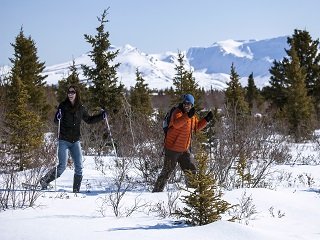 It’s been a fun ride, but today we end our primer on snowshoeing by highlighting perhaps the most important aspect of it—and every outdoor activity: staying safe. Winter can be a treacherous season, especially in the backcountry, so learning how to stay safe by taking the necessary precautions, being prepared, and arming yourself with the knowledge of what to do in an emergency will be vital. Keep reading to learn a bit about how to keep safe when you’re snowshoeing this winter.
It’s been a fun ride, but today we end our primer on snowshoeing by highlighting perhaps the most important aspect of it—and every outdoor activity: staying safe. Winter can be a treacherous season, especially in the backcountry, so learning how to stay safe by taking the necessary precautions, being prepared, and arming yourself with the knowledge of what to do in an emergency will be vital. Keep reading to learn a bit about how to keep safe when you’re snowshoeing this winter.
Any physical activity is great for exercise, but it’s important to know your body’s limits and toe the line. Snowshoeing is no different, and it’s important to stay within the limits set by your physical abilities, the environment in which you’ll be hiking, and your gear. It wise to stick to established trails at first. This shouldn’t be too difficult, since many ski areas typically have cross-country ski trails that snowshoers can share (just stay off the ski tracks). That way, you're sure to never be too far from other people and you're not likely to encounter avalanche hazards, since trails will usually be in safer areas.
You’ll want to scout/research your planned trails beforehand by checking on their status with local rangers, as well as familiarizing yourself with the terrain of the outdoors. Backcountry travel has certain hazards you need to be able to recognize, such as creek crossings, changing weather, and avalanche conditions. Learning about these hazards before you go into the backcountry will be a big tool to have in your arsenal. Pay attention to signs of unstable snow and either reroute your trip or turn back if necessary. Remember, it’s your responsibility to be aware of your surroundings; no one else is going to do it for you.
If you plan on hiking off the beaten path, prepare for such a venture by carrying a topographic map of the area, a compass, and possibly a GPS to help you navigate. Furthermore, make sure you know how to use them, because the backcountry in winter is not the best place to learn. There are videos online, as well as outdoor classes on map and compass navigation and GPS usage, so you have ample available options.
If you plan to go into the backcountry in potentially dangerous areas, make sure to carry an avalanche beacon, probe, and a shovel. Also, check snow and weather conditions before you head out and plan your trip to avoid any avalanche-prone slopes or inclement weather.
If at all possible, do not snowshoe alone. I know this isn’t necessarily unavoidable all the time, but it’s just safer to have someone with you. If nothing else, a companion is someone to talk to and share the adventure with. Lastly, before heading out, be sure to leave your trip plans with a responsible person and let them know whom to contact in case you don't return on time.
Covering all your bases and preparing ahead of time will help ensure that your snowshoeing ventures are safer and more enjoyable. I hope your own snowshoeing trips are exciting and memorable. Just because there’s some snow on the ground, it doesn’t mean your outdoor activities need to be put on hold. Snowshoeing is a great way to get out this winter and hopefully this guide has helped you get started on the right foot!








